Explore Hanoi - North Vietnam Travel, Asia
Nestled along the banks of the Red River in northern Vietnam, Hanoi stands as a captivating blend of ancient charm and modern dynamism. As the cultural heart and bustling capital of Vietnam, Hanoi beckons travelers with its vibrant street life, historical landmarks, and rich tapestry of traditions.
Learn all about the available tours in Vietnam here.
Population: Approximately 8.5 millions in 2022.
Economy: Capital city of Vietnam and one of the fastest-growing cities in the world.
Landmarks: Famous for Hoan Kiem Lake, Ho Chi Minh Mausoleum, and The Old Quarter.
Vietnam

Overview of Hanoi
History & Cultural Influence
Steeped in over a thousand years of history, Hanoi has been shaped by a diverse array of influences, from ancient Vietnamese dynasties to French colonial rule. The city's historical narrative unfolds through its architectural marvels, such as the Imperial Citadel of Thang Long from the Ly Dynasty, the majestic Ho Chi Minh Mausoleum, a testament to Vietnam's revolutionary leader. French colonial architecture dots the cityscape and blends smoothly with the imperial era ones. These structures not only showcase Hanoi's architectural splendor but also highlight its cultural exchange between the West and the East.
Interaction with The Locals in Hanoi
One of the most enriching aspects of visiting Hanoi is the opportunity to engage with its warm-hearted locals. Known for their hospitality and vibrant community spirit, Hanoians welcome visitors with open arms, eager to share their customs and traditions. Whether you're savoring a steaming bowl of Pho at a street-side stall or bargaining at bustling markets like Dong Xuan, interacting with locals offers insights into their daily life and culture. From the lively discussions while sitting at a street coffee shop or capturing memories in a quieter corner of the Old Quarter, every interaction in Hanoi is a chance to forge meaningful connections.
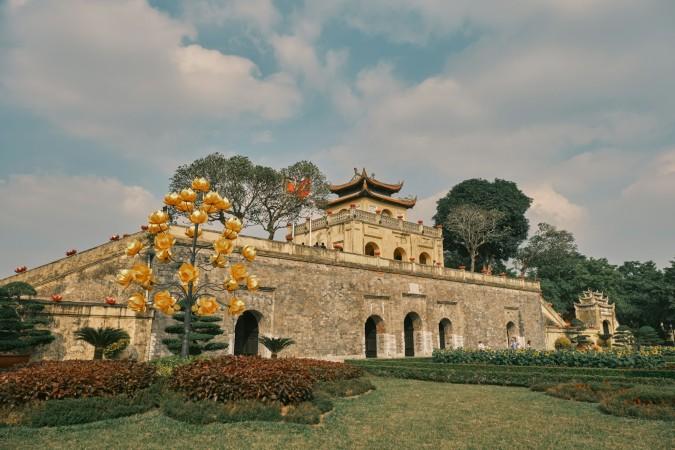
Citadel of Thang Long - © snap shoot
Top Attractions in Hanoi
Discover the essence of Hanoi through its iconic landmarks and cultural treasures that captivate travelers from around the globe:
- Hoan Kiem Lake and Ngoc Son Temple: Tranquil Hoan Kiem Lake, also known as the Lake of the Restored Sword, is a serene oasis in central Hanoi. Admire the picturesque Turtle Tower and visit Ngoc Son Temple, perched on a small island, for a glimpse into local legends and spiritual rituals.
- Ho Chi Minh Mausoleum: Pay tribute to Vietnam's revolutionary leader at the solemn Ho Chi Minh Mausoleum, where visitors may see the embalmed body of Ho Chi Minh and learn about his vital role in Vietnamese history.
- Temple of Literature: Travel back in time to the Temple of Literature, Vietnam's first university and a marvel of traditional Vietnamese architecture. Explore its peaceful courtyards, ancient stone tablets, and majestic Confucian statues.
- Hanoi Old Quarter (Hoan Kiem District): Immerse yourself in the vibrant chaos of Hanoi's Old Quarter, a maze of narrow streets brimming with centuries-old architecture, bustling markets, and traditional shops. Wander through Hang Gai Street for silk products and Hang Bac Street for jewelry.
- Hoa Lo Prison Museum: Gain insights into Vietnam's tumultuous history at the Hoa Lo Prison Museum, famously known as the "Hanoi Hilton." Discover the stories of Vietnamese revolutionaries and American prisoners of war held here during the Vietnam War.
- Hanoi Train Street: Experience the unique spectacle of Hanoi Train Street, where trains pass through a narrow residential street just inches away from homes and cafes. Witness the local tradition of moving furniture and belongings off the tracks moments before the train's arrival, offering a glimpse into daily life along the railway.
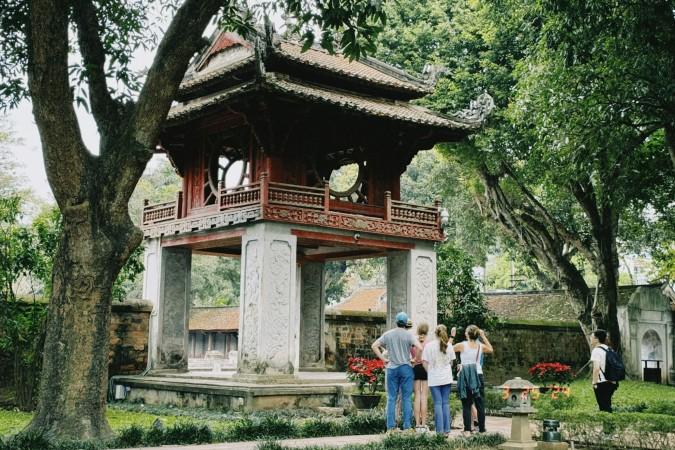
Temple of Literature - © JM Eserjose
Must-Try Dishes in Hanoi
Delight your taste buds with Hanoi's renowned culinary creations, showcasing a blend of flavors and traditions that define Vietnamese cuisine:
- Pho: Indulge in Vietnam's national dish, Pho, a flavorful noodle soup made with savory broth, fresh herbs, and tender slices of beef or chicken. Sample this beloved street food at local eateries like Pho Bat Dan or Pho Thin.
- Bun Cha: Savor the smoky flavors of Bun Cha, grilled pork served with vermicelli noodles, herbs, and a dipping sauce infused with garlic, chili, and lime. Head to Dac Kim or Bun Cha Huong Lien, famously visited by former U.S. President Barack Obama.
- Banh Mi: Taste the iconic Banh Mi, a French-inspired baguette sandwich filled with a medley of ingredients such as pate, pickled vegetables, cilantro, and your choice of meats like grilled pork or pate.
- Cha Ca La Vong: Experience Cha Ca La Vong, a Hanoi specialty of marinated fish filets grilled with turmeric and dill, served with vermicelli noodles, peanuts, herbs, and shrimp paste sauce.
- Egg Coffee (Ca Phe Trung): Indulge in the unique flavor of Egg Coffee, a Hanoi invention where rich Vietnamese coffee is topped with whipped egg yolk foam, creating a decadent and creamy treat. Enjoy it at Giang Cafe, one of the first restaurants that provide this dish.
Do you know that the cuisine in Northern Vietnam is slightly different from the south? Learn more about signature dishes of Ho Chi Minh city, the central of Southern Vietnam here.
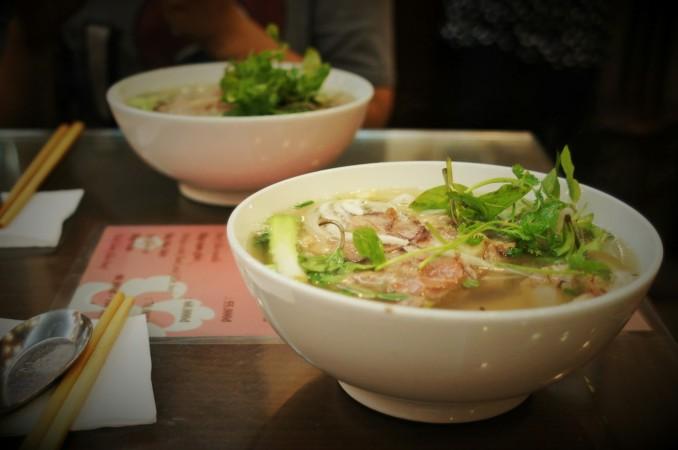
Pho in Hanoi - © Nat.chee Kim
Festivals & Local Celebrations
Immerse yourself in Hanoi's vibrant cultural tapestry through its lively festivals and celebrations that highlight the city's traditions and community spirit:
Tet in Hanoi (Lunar New Year)
Join in the festivities of Tet, Vietnam's most significant holiday, marked by colorful parades, lion dances, fireworks, and family gatherings. Experience traditional customs like giving red envelopes (li xi) and enjoying special Tet dishes.
Mid-Autumn Festival
Celebrate Tet Trung Thu, the Mid-Autumn Festival, with lantern processions, children's performances, and mooncake tastings. Join locals in parks and streets adorned with colorful lanterns as they celebrate the harvest season and family reunion.
Hanoi Book Fair
Immerse yourself in literary delights at the Hanoi Book Fair, held annually at Thang Long Imperial Citadel. Browse through a vast array of books, attend author signings, and participate in literary discussions and workshops celebrating Vietnamese and international literature.
Hanoi Flower Festival
Admire the beauty of floral displays and garden landscapes at the Hanoi Flower Festival, held annually during the Lunar New Year (Tet) period. Explore themed gardens, attend floral arrangement workshops, and enjoy cultural performances amidst a tapestry of blooming flowers. As a tropical country, you can find beautiful and stunning flower roads and fields across Vietnam.
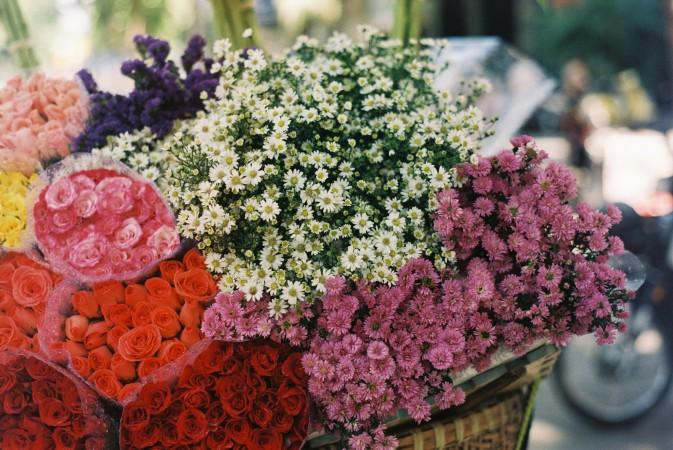
A Flower Vendor in Hanoi - © Thu Anh Doan
What to Do in Hanoi
Explore Hanoi's dynamic attractions and activities that cater to every traveler's interests, from cultural explorations to adventurous outings:
- Water Puppet Theater: Attend a traditional water puppet show at Thang Long Water Puppet Theater, where intricately crafted puppets perform on a water stage to live music. Experience Vietnamese folklore and storytelling through this unique art form.
- Cyclo Tours: Embark on a cyclo tour through Hanoi's bustling streets, guided by skilled cyclo drivers who navigate through the Old Quarter's narrow alleys and historic landmarks. Capture panoramic views of the city's vibrant life and architectural wonders.
- Cooking Classes: Enroll in a cooking class to learn the secrets of Vietnamese cuisine from expert chefs. Visit local markets to select fresh ingredients before mastering techniques to prepare traditional dishes like spring rolls, caramelized fish, or banana flower salad.
- Biking around West Lake: Rent a bicycle and cycle around scenic West Lake, exploring its pagodas, gardens, and lakeside cafes. Enjoy panoramic views of Hanoi's skyline and cultural landmarks while immersing yourself in the peaceful ambiance of this expansive water body.
- Bat Trang Ceramic Village: Embark on a cultural excursion to Bat Trang Ceramic Village, located on the outskirts of Hanoi. Learn the making of traditional ceramic craftsmanship and shop for intricately designed pottery, and even try your hand at creating ceramic pieces.
Shopping in Hanoi
Discover Hanoi's vibrant markets and boutique shops, where you can find unique souvenirs, handicrafts, and fashionable goods:
- Dong Xuan Market: Navigate the bustling aisles of Dong Xuan Market, Hanoi's largest indoor market, offering everything from clothing and electronics to local snacks and souvenirs. Bargain with vendors for traditional Vietnamese lacquerware, silk products, and bamboo goods.
- Hang Gai Street (Silk Street): Explore Hang Gai Street, also known as Silk Street, renowned for its exquisite silk products and tailor-made clothing. Browse through boutique shops offering silk scarves, ao dai (traditional Vietnamese attire), and intricately embroidered textiles.
- Hanoi Night Markets: Experience Hanoi's vibrant night markets, such as the weekend night market in the Old Quarter or the Hang Dao Street night market. Stroll through illuminated stalls selling handicrafts, street food, and local delicacies amidst the lively nighttime ambiance.
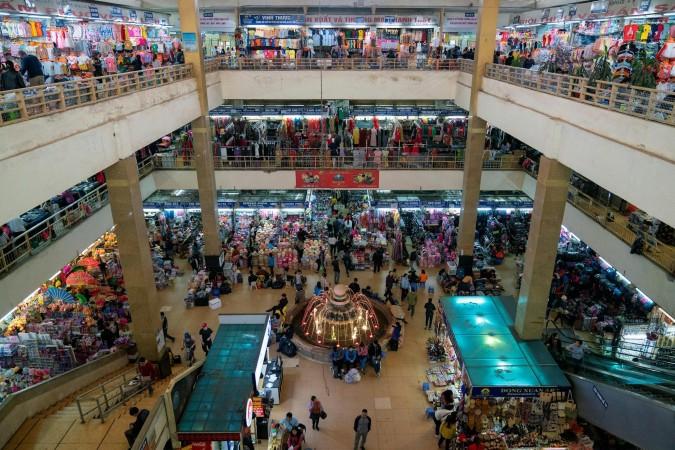
Dong Xuan Market - © Jason Rost
Weather in Hanoi: Best Time to Visit
Understanding Hanoi's weather conditions is essential for planning an enjoyable visit, as they significantly influence the best times to explore the city and partake in various activities:
Spring in Hanoi
- Weather: Spring in Hanoi is distinguished by mild temperatures, ranging from 17°C to 23°C (63°F to 73°F). The weather is quite pleasant with low humidity and occasional light rain showers.
- Seasonal Highlights: Ideal for flower festivals and outdoor explorations.
- Tourism Trends: This season is one of the best times to visit Hanoi, attracting many tourists who enjoy the blooming flowers and verdant landscapes. Popular activities include sightseeing, visiting parks and gardens, and exploring historical sites.
Summer in Hanoi
- Weather: Summer in Hanoi has temperatures ranging from 25°C to 35°C (77°F-95°F). The city experiences frequent heavy rains and thunderstorms, particularly in July and August, making it hot and humid.
- Seasonal Highlights: Vibrant local festivals and indoor cultural experiences.
- Tourism Trends: Despite the heat and rain, summer is a busy season with several local festivals and events. Tourists who don't mind the weather can find unique cultural experiences and fewer crowds at popular attractions.
During summer, it's worth to also visit stunning beaches in Nha Trang, a coastal city located in Central Vietnam. Learn all the things you need to know when visiting Nha Trang here.
Autumn in Hanoi
- Weather: Autumn is arguably the best season to visit Hanoi, with temperatures ranging from 20°C to 28°C (68°F to 82°F). The weather is comfortable, with lower humidity and clear skies.
- Seasonal Highlights: Best for sightseeing, outdoor activities, and cultural festivals.
- Tourism Trends: This season sees a peak in tourist arrivals due to the pleasant weather. It is an excellent time for outdoor activities, cultural festivals, and exploring the city's rich heritage.
Winter in Hanoi
- Weather: Winter in Hanoi is cold yet still maintains the feeling of humidity, with temperatures ranging from 10°C to 20°C (50°F to 68°F). January is the coldest month, and temperatures can drop significantly, especially at night.
- Seasonal Highlights: Cultural immersion during Tet and cozy indoor attractions.
- Tourism Trends: Winter is a great time to experience Hanoi's cultural depth, as it coincides with the Lunar New Year (Tet) celebrations. While it is less crowded than autumn, it offers a unique glimpse into local traditions and customs.
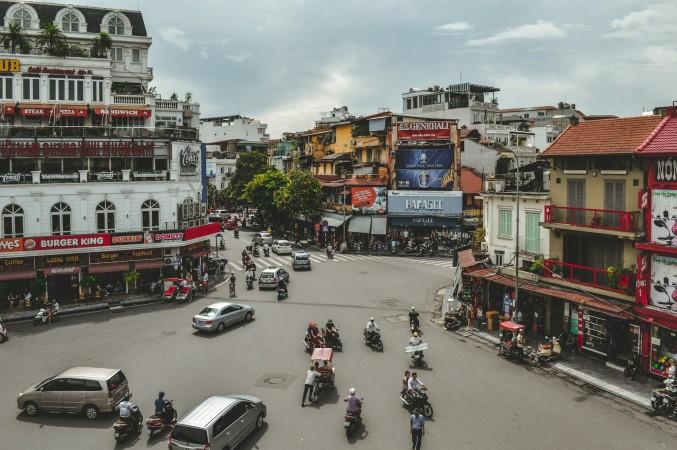
Summer morning in Hanoi - © Josh Stewart
Culture Etiquette in Hanoi
Navigating cultural norms and etiquette in Hanoi enhances your travel experience and fosters respectful interactions with locals.
- Respect for Elders: Show respect to elders by addressing them with appropriate titles and gestures, such as bowing slightly when greeting or offering assistance.
- Dress Modestly: When visiting temples, pagodas, or formal settings, dress modestly and remove shoes before entering. Avoid wearing exposing apparel or beachwear in public.
- Public Behavior: Maintain a calm demeanor in public spaces and refrain from public displays of affection. Use quiet tones in conversation, especially in areas of worship or quiet contemplation.
- Dining Etiquette: When dining with locals, wait to be seated and follow their lead regarding seating arrangements and meal service. Use chopsticks respectfully and refrain from placing chopsticks upright in a bowl, as it symbolizes death.
Essential Travel Information
Getting Around Hanoi
A range of transportation alternatives appeal to diverse interests and prices, making it easier to navigate Hanoi's crowded streets.
- Motorbike Taxis (Xe Om): Convenient for short distances, motorbike taxis are readily available throughout Hanoi. Negotiate fares beforehand and wear a helmet for safety.
- Public Buses: Hanoi's extensive bus network covers most areas of the city, offering a budget-friendly option for getting around. Check route maps and schedules at local bus stops, and have precise change ready for tickets.
- Cyclos and Pedicabs: Enjoy a leisurely ride through Hanoi's Old Quarter aboard a cyclo or pedicab. Negotiate fares in advance and soak in the sights and sounds of bustling streets from a unique perspective.
- Taxi Services: Metered taxis are plentiful in Hanoi, providing a convenient option for longer journeys or traveling in comfort. Opt for reputable taxi companies and ensure meters are used to avoid overcharging.
- Ride-Hailing Apps: Apps like Grab offer convenient and transparent transportation options, including cars, motorbikes, and even bicycles. To make things easier, book rides ahead of time and pay using the app.
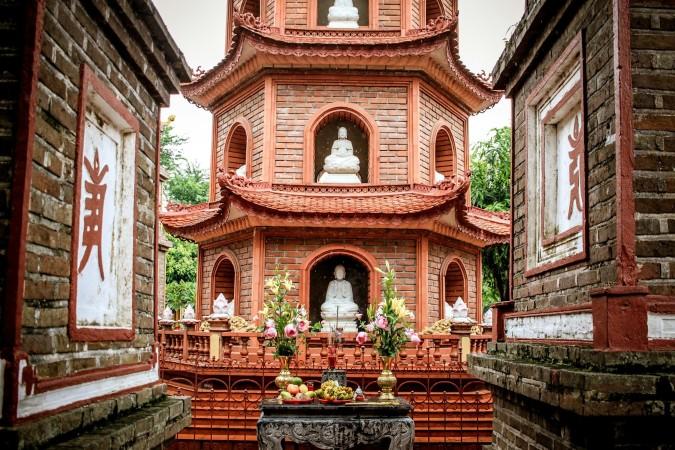
Tran Quoc Pagoda - © Frida Aguilar Estrada
ATM & Banking Services
Hanoi offers comprehensive banking services and widespread ATM availability, especially in tourist areas, major hotels, and shopping malls. Currency can be exchanged at banks, authorized counters, and hotels, while major credit cards are widely accepted in hotels, restaurants, and upscale shops. Traveler's checks, though less common, can be exchanged at banks or large hotels. Ensure smooth transactions by informing your bank of travel plans and carrying sufficient cash for smaller purchases.
Where to Stay in Hanoi
Hanoi offers a diverse range of accommodations to suit every budget and travel style. For luxury seekers, there are internationally acclaimed hotels with world-class amenities and impeccable service. Boutique hotels provide unique charm and personalized hospitality, blending cultural flair with modern comforts. Budget-conscious travelers can find affordable and clean options at hostels and budget hotels, while those on extended stays might prefer serviced apartments that offer home-like comforts and additional space. For a more immersive experience, homestays and guest houses in residential neighborhoods offer authentic Vietnamese culture, home-cooked meals, and personalized local insights.
Articles for you

Explore Yala National Park - Sri Lanka Travel, Asia
Tucked away in Sri Lanka’s southeastern corner, Yala National Park is where wild nature meets deep tradition. Known worldwide for its leopard population, the park is also home to elephants, sloth bears, crocodiles, and hundreds of bird species. Beyond wildlife, Yala opens doors to a cultural landscape dotted with ancient temples, Buddhist ruins, and coastal villages. For travelers seeking more than just a safari, Yala offers a chance to explore eco-tourism, local communities, and sacred heritage sites.
Population: The Yala National Park area doesn’t have a human population.
Economy: The economy around Yala National Park thrives on a blend of eco-tourism, agriculture, and local services. Safari tours, eco-lodges, and cultural experiences drive steady income for nearby towns like Tissamaharama and Kataragama, supporting thousands of families.
Landmarks: Famous for Block I of Yala and wildlife encounters, including elephants, sloth bears, crocodiles, and exotic bird species.

Explore Galle - Sri Lanka Travel, Asia
Nestled on Sri Lanka’s southern coastline, Galle is a vibrant city where history meets the sea. Its cobbled streets, colonial architecture, and serene beaches make it a must-visit destination for travelers seeking a blend of culture, adventure, and relaxation. A UNESCO World Heritage site, Galle captivates visitors with its Dutch Fort, bustling markets, and friendly locals. Whether you’re exploring the ramparts at sunset or savoring fresh seafood by the shore, Galle promises an unforgettable journey into Sri Lanka’s heritage.
Population: Approximately 113,000 in 2023.
Economy: Galle’s economy thrives on tourism, trade, and fisheries. The city’s historic fort, colonial architecture, and coastal charm draw thousands of international visitors each year, making tourism its main economic driver. Fishing remains vital for local livelihoods, supplying fresh seafood across the region.
Landmarks: Famous for the Galle Fort, Dutch Reformed Church & Maritime Museum, and Unawatuna Beach.

Explore Bentota - Sri Lanka Travel, Asia
Nestled along Sri Lanka’s southwestern coast, Bentota is a tropical paradise that blends golden beaches, vibrant culture, and thrilling adventures. Famous for its calm waters, luxury resorts, and scenic river estuary, Bentota has become a top destination for travelers seeking both relaxation and authentic experiences. From serene beach walks at sunrise to adrenaline-pumping water sports, this coastal town offers a perfect balance of leisure and exploration. With its proximity to Colombo and Galle, Bentota is easy to reach, making it an ideal stop for both short escapes and extended holidays.
Population: Approximately 37,000 in 2023.
Economy: Bentota’s economy thrives mainly on tourism, which drives local businesses such as hotels, restaurants, and wellness retreats. The town also benefits from fishing, coconut cultivation, and handicrafts like wood carving and batik textiles. Many residents rely on the growing demand for water sports and Ayurvedic treatments, making tourism the backbone of both income and employment in the area.
Landmarks: Famous for Bentota Beach, Bentota River Safari, and Kande Vihara Temple.

Explore Mirissa - Sri Lanka Travel, Asia
Mirissa is a charming coastal town on Sri Lanka’s southern shoreline. Known for its golden beaches, turquoise waters, and vibrant marine life, it has become a must-visit stop for travelers exploring the island. Many come for whale watching, surfing, and sunset views at Coconut Tree Hill, but Mirissa offers much more than postcard beauty. The fishing boats you see anchored by the bay carry generations of stories. Local traditions, delicious cuisine, and a laid-back rhythm of life shape every visitor’s experience.
Population: Approximately 4,700 in 2023.
Economy: Mirissa’s economy is largely shaped by its coastal location. Fishing has long been the backbone of local livelihoods, with generations relying on the Indian Ocean for income. In recent decades, tourism has become the main driver of growth, thanks to whale watching, surfing, and beachside hospitality.
Landmarks: Famous for Mirissa Beach, Coconut Tree Hill, and Parrot Rock Bridge.

Explore Nuwara Eliya - Sri Lanka Travel, Asia
Tucked away in the Central Highlands of Sri Lanka, Nuwara Eliya is often called “Little England”. With its rolling tea plantations, cool misty mornings, and colonial charm, this mountain town feels like a step into another world. Travelers come here to breathe fresh air, walk through flower gardens, sip the finest Ceylon Tea, and enjoy a pace of life far from the island’s busy cities. Whether you’re drawn by scenic landscapes, heritage architecture, or the warmth of its people, Nuwara Eliya is a destination that blends nature, culture, and history in perfect harmony.
Population: Approximately 781,000 in 2023.
Economy: Nuwara Eliya’s economy thrives mainly on tea production, as it sits in the heart of Sri Lanka’s central highlands, famous worldwide for Ceylon Tea. The city also benefits from a growing tourism industry, attracting visitors with its colonial charm, cool climate, and scenic landscapes.
Landmarks: Famous for Gregory Lake, Hakgala Botanical Garden, and Victoria Park.

Explore Sukau - Malaysia Travel, Asia
Nestled on the banks of the Kinabatangan River in Sabah, Malaysian Borneo, Sukau is a destination where wildlife, culture, and conservation come together. Known as one of Asia’s top spots for river safaris and eco-tourism, this quiet village offers a front-row seat to encounters with Bornean orangutans, pygmy elephants, proboscis monkeys, and exotic birdlife.
Population: Approximately 1,400 in 2019.
Economy: Sukau’s economy is shaped by its riverine location and natural resources. Traditionally, the Orang Sungai community relied on fishing, small-scale farming, and forest gathering for their livelihood. Today, the village has shifted toward eco-tourism, with river cruises, jungle trekking, and homestays providing income.
Landmarks: Famous for the Kinabatangan River cruises, Gomantong Caves, and Ox-bow lakes and wetlands.
